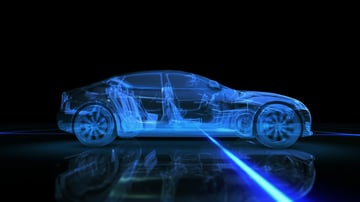The Future of Electronic Power Steering: Are You Ready?
 Power steering systems have remained largely unchanged for the past 50 years or so. However, today is the age of "smart" technology: smartphones, smart homes, and of course, smart cars have followed. One of the biggest innovation trends among auto manufacturers is the updating of electronic power steering. The future of electronic power steering is undeniably digital, and the changes might be coming sooner than you think.
Power steering systems have remained largely unchanged for the past 50 years or so. However, today is the age of "smart" technology: smartphones, smart homes, and of course, smart cars have followed. One of the biggest innovation trends among auto manufacturers is the updating of electronic power steering. The future of electronic power steering is undeniably digital, and the changes might be coming sooner than you think.
To find out what to expect in the electronic power steering arena and how to prepare your team accordingly, keep reading.
The Future of Electronic Power Steering Technology
 The power steering industry is already moving towards several advancements in electronic power steering technology that will not only change the way people drive, but also the way power steering shops will need to service newer vehicles. As with advancements in countless other industries and products today, the future of electronic power steering is headed in the digital direction. While these electronic control concepts have been around for a while, only today are manufacturers getting more serious about making them more effective, and more common, on the road. The two largest technologies you need to be prepared for are steer-by-wire systems and adaptive steering.
The power steering industry is already moving towards several advancements in electronic power steering technology that will not only change the way people drive, but also the way power steering shops will need to service newer vehicles. As with advancements in countless other industries and products today, the future of electronic power steering is headed in the digital direction. While these electronic control concepts have been around for a while, only today are manufacturers getting more serious about making them more effective, and more common, on the road. The two largest technologies you need to be prepared for are steer-by-wire systems and adaptive steering.
Steer-by-wire
As part of the digital "drive-by-wire" umbrella of innovations, steer-by-wire technology is a digital power steering system that replaces the physical steering controls that have been used in vehicles for decades. Most vehicles you've encountered in the past use a rack and pinion or worm and sector gear to control the power steering — physical components that connect the steering wheel to the system that controls the steering. With steer-by-wire, those physical controls are no longer present. Instead, electronic sensors that communicate to the power steering system what actions the driver is taking at the wheel. You can actually compare the concept to the way a steering wheel you use to play racing video games works: when you turn the wheel, sensors tell the car onscreen which way you want it to go. At the same time, a steering feel emulator provides the driver with feedback about the vehicle's actions as well. Technically, you wouldn't even need a traditional steering wheel to control a steer-by-wire system, but when Infiniti produced the first steer-by-wire model in 2013, it did feature a steering wheel. A steer-by-wire system could free up a lot of space under the hood, reduce vibrations, and potentially save on fuel economy.
Adaptive Steering
Ford is the manufacturer currently at the forefront of adaptive steering, launching the technology in its 2016 Edge model (though other manufacturers like BMW, Audi, and Lexus are also working with the concept). Much like steer-by-wire, adaptive steering depends on innovative electronic systems that work along with the ESC in the vehicle to adapt to changing conditions that might affect stability, like road unevenness or traction. This "smart" technology is housed within the steering wheel and communicates with the ESC to correct instability for a smoother, more comfortable driving experience. How does it work? By changing the ratio of the driver's actions and at the rack depending on the vehicle's speed. At lower speeds, adaptive steering allows for easy maneuverability by shifting steering to the road wheel, requiring less turning of the wheel in order to turn the vehicle. At higher speeds, driver input is processed more quickly, allowing steering to react more precisely to the driver's actions. The main benefit of adaptive steering is the added driver comfort and smoothness of control at all speeds.
Electronic Power Steering Changes You Can Prepare For Today
 While manufacturers are still working to grasp the intricacies of new EPS technologies (in fact, Nissan had to recall the Infiniti Q50 because freezing engine compartments could cause steering failure), their revolution is certainly on the way. The best thing you can do for your power steering shop is to prepare your setup and employees now for the innovations of tomorrow. (If you happen to be interested in the implications of autonomous power steering, check out our recent post on that technology.) Here are a few of the changes you can expect to deal with in the next decade:
While manufacturers are still working to grasp the intricacies of new EPS technologies (in fact, Nissan had to recall the Infiniti Q50 because freezing engine compartments could cause steering failure), their revolution is certainly on the way. The best thing you can do for your power steering shop is to prepare your setup and employees now for the innovations of tomorrow. (If you happen to be interested in the implications of autonomous power steering, check out our recent post on that technology.) Here are a few of the changes you can expect to deal with in the next decade:
- Because steer-by-wire and adaptive steering systems rely on electronic controls, the components of the power steering application need to be able to communicate in high speed. In response, the bandwidth you'll be working with inside the vehicle will increase. This is one of the biggest challenges in developing digital EPS technology, and will certainly be one of the biggest challenges in servicing them as well. The best way to prepare your team for this advancement is to enact training standards dealing with CAN buses, as well as more high-speed communications.
- The future of electronic power steering looks a lot less manual and a lot more digital — that much should be clear. What's important to remember is the way that affects the work that goes into servicing these units. EPS systems tend to have less variation, and work like grinding and shaping parts will be largely eliminated in favor of electronic calibration. These changes might actually mean positive things for your shop: calibration service can generally be done more quickly than manual service, and less confusion about which OEM parts are the right ones bolster efficiency.
- Finally, it's crucial that your business starts addressing power steering sensors along with the other power steering services you offer, like alignment. For one thing, this option tells your customers that you're ahead of the curve when it comes to technology. But it's also likely that you'll start to encounter more and more vehicles with EPS sensor technologies, and you need a plan or a program in place to handle them. It'll take special training, advanced scanning tools, and a willingness to adapt to the changing market, but the sooner you start preparing for the future of electronic power steering, the better.


